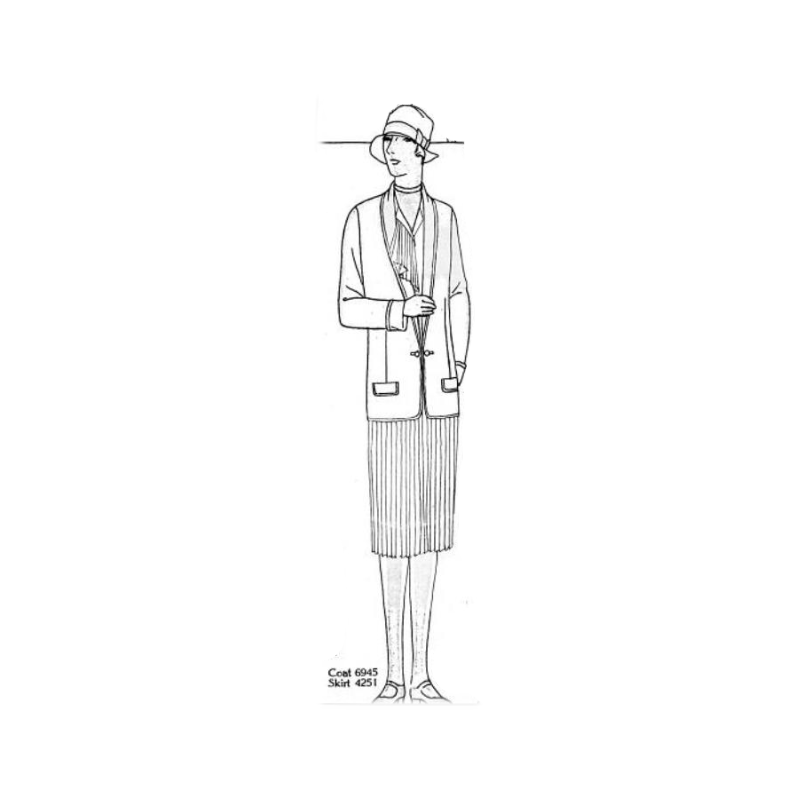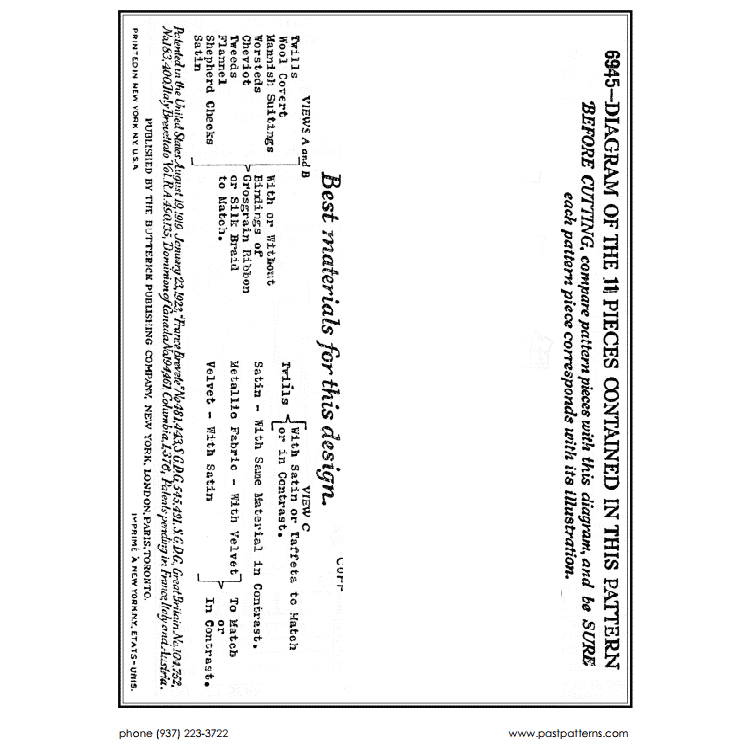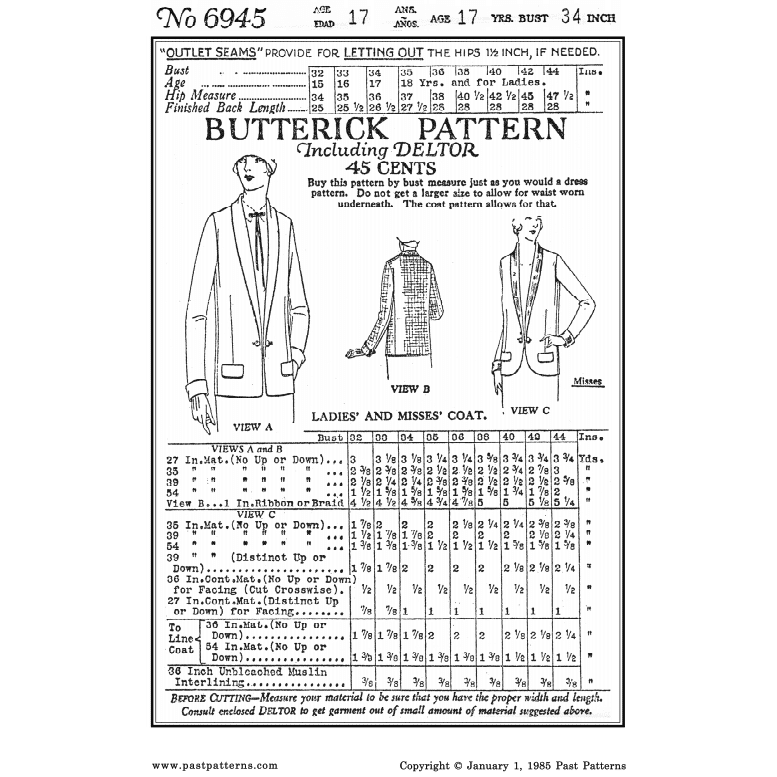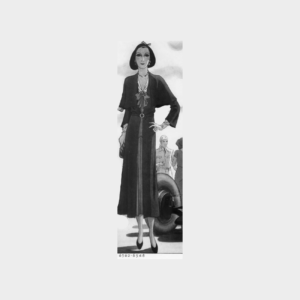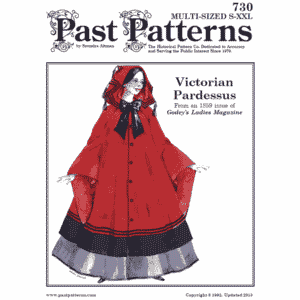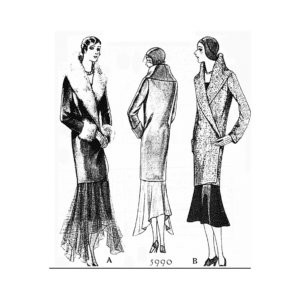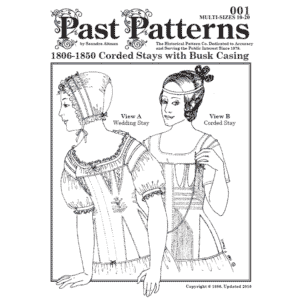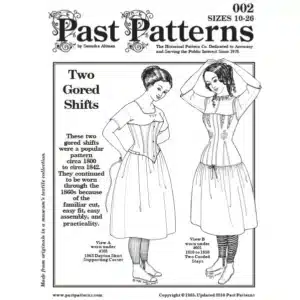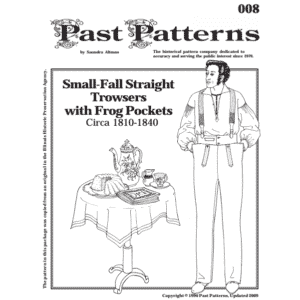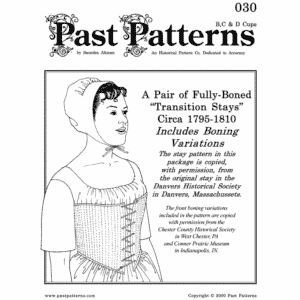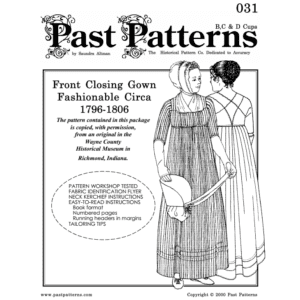Late 1920s Young Ladies Tuxedo Jacket Sewing Pattern bust 34 b34 Butterick Pattern Co reproduction
$18.00
Dated to July 1926
Size: 34″ bust, 36″ hips
Pattern features three Styles of the Butterick Coat
There are 11 pattern pieces in this set
3/8″ Seam Allowance unless noted on pattern piece
Get Free Shipping
On all US Orders over $50!
Late 1920s Young Ladies Tuxedo Jacket Sewing Pattern bust 34 b34 Butterick Pattern Co reproduction
$18.00
Dated to July 1926
Size: 34″ bust, 36″ hips
Pattern features three Styles of the Butterick Coat
There are 11 pattern pieces in this set
3/8″ Seam Allowance unless noted on pattern piece
Get Free Shipping
On all US Orders over $50!
All of our patterns tell a story.
Why Choose This Pattern?
This Late 1920s Ladies Tuxedo Jacket Sewing Pattern was originally released by The Butterick Pattern Co
★ ★ ★ ★ ★ ★ ★ ★
The 1920s was a time of significant social change, with women gaining more independence and expressing it through fashion. The ladies' tuxedo jacket of 1926 would be a bold statement of equality and modernity, blending masculine elements with a distinctly feminine flair. It reflects the era's spirit of liberation and the breaking of traditional gender norms in fashion.
Pattern 6954 was advertised in the July 1926 issue of the Delineator, page 33.
The very brief description said, "The tuxedo line is new for a coat of flannel, tweeds, shepherd checks, cheviot, etc."
Marlene Dietrich, the iconic actress and singer, is often credited with popularizing the concept of women wearing tuxedos. She famously wore a tuxedo in the 1930 film Morocco, challenging gender norms and creating a bold fashion statement.
On the original packaging, this garment was described as a "Ladies' and Misses' Coat. Hip pockets and cuffed sleeves, linked button closure, hits at hip, rolled over collar."
2 variations of the Butterick Coat can be created from this pattern.
★ ★ ★ ★ ★ ★ ★ ★
This pattern set was designed to fit the size and shape of a 1920s woman with 34” bust and 36” hips. This is the only size we offer of this package.
For resizing information, see https://pastpatterns.com/resizing-vintage-patterns/
There are 11 pattern pieces in this set
3/8" Seam Allowance unless noted on pattern piece
★ ★ ★ ★ ★ ★ ★ ★
Material Requirements
2 1/2 Yds 36” wide fabric
Butterick suggested using, "For Views A and B - twills, wool covert, mannish suitings, worsteds, cheviot, tweeds, flannel, shepherd checks, or satin, each with or without Binding of Grosgrain Ribbon or Silk Braid to match. For View C - Twills, with satin or taffeta to match or in contrast, Satin, with same material in contrast, metallic fabric with velvet or velvet with satin. For the metallic fabric and velvet options, use the secondary fabric to match or contrast."
Per query to ChatGPT in June 2024, "Mannish suiting" refers to women's fashion inspired by traditional men's tailoring. This style often includes elements such as structured blazers, tailored trousers, crisp shirts, and sometimes accessories like ties or cufflinks. The term "mannish" doesn't mean the clothing is meant for men; rather, it borrows design elements from men's fashion to create a distinctive and often empowering look for women.
Saundr Altman, our founder and noted fashion historian, recommended, "common colors for garments like this were tan, black, burgundy, light green, light navy blue, and navy blue."
★ ★ ★ ★ ★ ★ ★ ★
This 1920s ladies coat package has a copy of the original artwork, a sizing chart and a material requirements chart on the front cover. On the back cover is a pattern diagram and suggestions for fabrics. Inside the booklet are excellent Cutting and Making the Garment instructions along with historical notes on the paper pattern industry from the era. We also include our Past Patterns Guide to Editing and Modifying Patterns Due to Bust Size. The patterns come on a 36” wide sheet and are hand-drawn, emulating the originals.
★ ★ ★ ★ ★ ★ ★ ★
Our patterns are printed on 20 lb. white paper and packaged in reusable plastic. We always attempt to offer the most reasonable shipping rates for domestic and international orders. Multi item purchases are automatically adjusted for combined shipping.
★ ★ ★ ★ ★ ★ ★ ★
Past Patterns 2024. All rights reserved.
Additional information
| Weight | 7 oz |
|---|---|
| Dimensions | 13 × 10 × 2 in |
Sizing Information

(Metric size sheet opens as a PDF in a new browser tab)
Preferred Vendors
Past Patterns works with vendors from all over the world to help us replicate the amazing articles of clothing. Now you can too!
Visit our preferred vendors page to order directly from some of our top recommended suppliers.
FAQ's
(Frequently asked questions)
Why are both Trowsers and Trousers listed on site?
Over the last 200 years, much like the human body, our style of language has changed. For vintage patterns, we attempt to use the language of the day where possible.
Can you grade (edit) a Vintage Revival pattern for my size?
please contact us with the specific pattern number and the specifications you require. We have staff available for this for an additional fee.
What sizes do Past Patterns patterns come in?
Our patterns, with some exceptions, are manufactured in sizes 8 through 26 for women and sizes 34 through 54 for men. Most patterns are multi-sized. For a complete listing of measurements in inches see the size chart.
Do you have vintage patterns (manufactured prior to 1950) that you want to sell?
we are always on the lookout for original, American designed, vintage patterns especially for categories outside of current items. We are interested if you have 1 pattern or 1000 patterns. Give us a call to discuss.
Why is my pattern size different from my off the rack dress size?
We use the U. S. Board of Standard Measurements to size our patterns. The ready made clothing manufacturers have their own set of sizes developed from their own statistics. For a complete listing of measurements in inches see the size chart.
How are the patterns packaged?
We package our patterns in two forms: Bond Paper and Tissue. Except for the Tissue patterns, each is slipped into a reusable plastic sleeve. Many contain documentation in the form of Historical Notes or the printer ie., Butterick. Because the patterns are printed in house to order, they can take from three to seven days. Tissue patterns, which are printed out of house, are available to ship immediately.
What does a Corset Kit contain in addition to the Corset pattern?
In addition to the pattern, the kits contain everything you need to make the corset except the thread. The kits contain, according to their type, fabric and lining, stays, clasp or busk board, back lacing, tape for finishing the edges, trim lace, ribbon, leather, tin stock, waist tape, punch and setter, eyelets, marking pencils, cording, reed and a loop turner.
Need a pattern in your language?
we can translate our instructions into just about any language
Have an old and incomplete Past Patterns item. What can I do?
The answer depends on if the pattern is still in production or not. If it is, please mail us the old pattern and we will ship you a copy of the latest pattern for a minimal fee along with normal shipping charges. If the item is no longer in production, we would need to know exactly what you have to determine the best course of action to help you.
What is the difference between a Past Patterns original pattern and a Vintage Revival pattern?
The Past Patterns originals were designed in house and based upon the research, disassembly and time of Saundra Ros Altman. These designs come from finds all over the United States reaching from San Diego, California to the Smithsonian Museum in Washington, DC. She created the initial patterns, the sizing charts and the instruction content. Many of the these patterns are multi-sized or are available in various sizes. For the most part, these designs are done taking into account the modern human body's shape, height and weight. The Vintage Revival patterns are traces or copies of an old, mass produced pattern; the first mass produced patterns came out in the 1850s. For the most part, you get exactly what came in the original package; in some cases, Saundra has appended historical notes to the instructions. The Vintage Revivals patterns, being copies of the originals, generally only come in one size and are based upon the size and shape of the human body from the era the pattern came from.
What software do you use to create patterns?
We utilize PW Studio for our designs. Isabelle Lott, a contributor over the years to Past Patterns, is the owner of the company and will be happy to answer an software related questions you have. Her software is available for licensing.
What measurements do I need to know to order a Corset Kit?
The bust and back length. The back length is measured from the prominent bone at the base of the neck to the natural waistline.
Where can I see the appropriate clothing fabrics for the 18th and 19th centuries?
You can see 1740 through 1940 fabrics in a book titled "Textile Designs" by Susan Meller and Joost Elffers. The subtitle states, "Two Hundred Years of European and American Patterns for Printed Fabric by Motif, Style, Color, Layout and Period and 1,823 Illustration in Color." What they don't say is that 90% of the swatches pictured are life size. The ISBN is 0-8109-3853-7. A second book is Wearable Prints, 1740-1860, History, Materials, and Mechanics by Susan W. Greene. The ISBN is 978-1-60635-124-6. Great books! Order it from your local library that has interlibrary loan capability if you cannot afford the price. There are now many sources for appropriate fabric through the Internet.
Where can I find antique patterns to purchase?
On the Internet try: "Patterns from the Past."
Need a pattern tomorrow?
we do offer expedited domestic shipping for extra fees. We can also expeditie international shipments but delivery dates overseas cannot be promised.
Becoming a Wholesalers of our patterns
We offer Wholesalers significant discounts that will allow both your and our businesses to flourish.
Why don't we sell PDFs of our patterns - First due to piracy. We have spent over 40 years creating and tracing these patterns along with researching them. We print and ship all of our patterns ourselves. If we started sending out PDFs, in no time, copies of our Intellectual Property would be all over the internet and we would be out of business. Second, some of our patterns are constantly being updated. We want our clients to get the BEST POSSIBLE version of our products.

